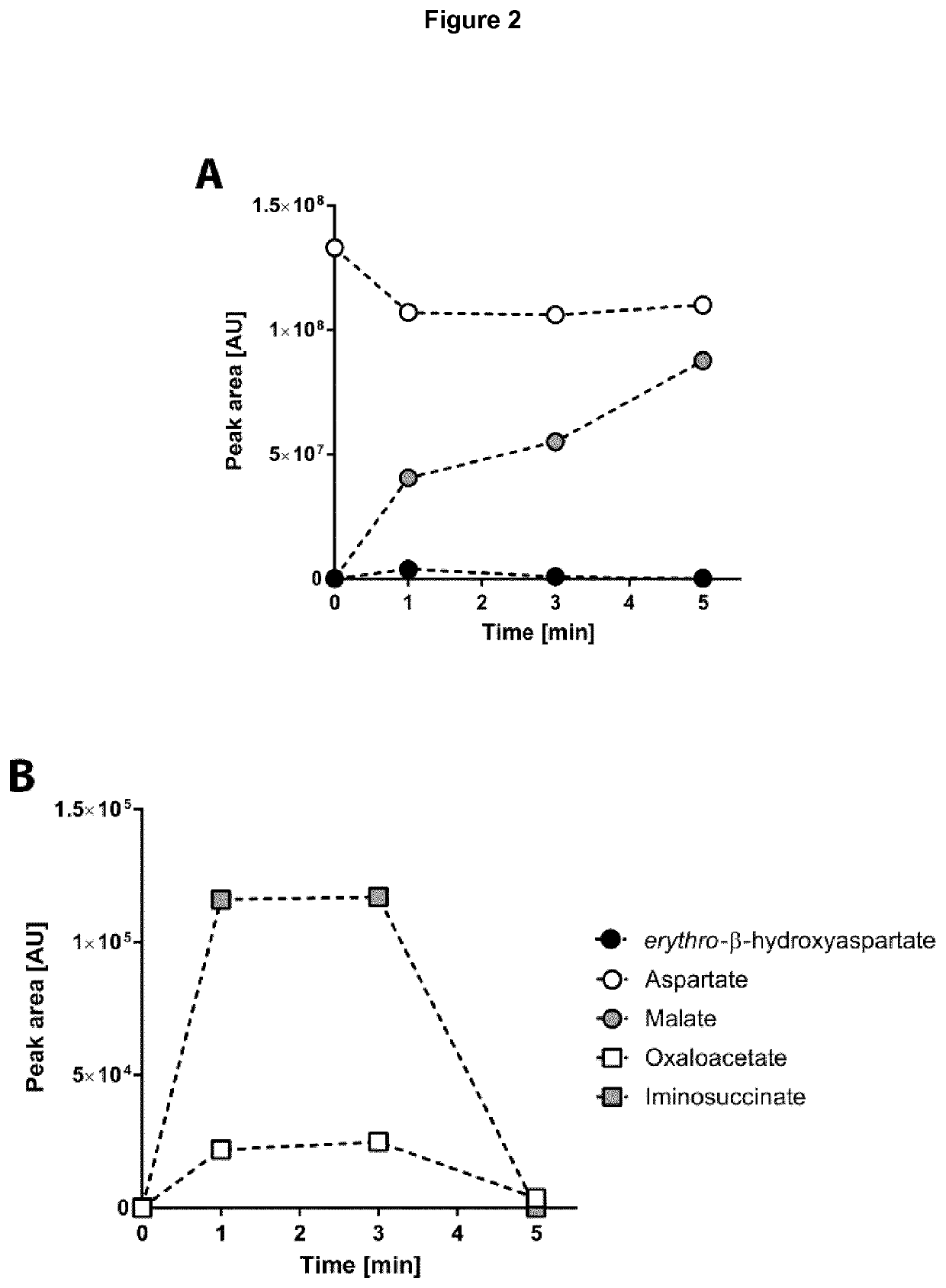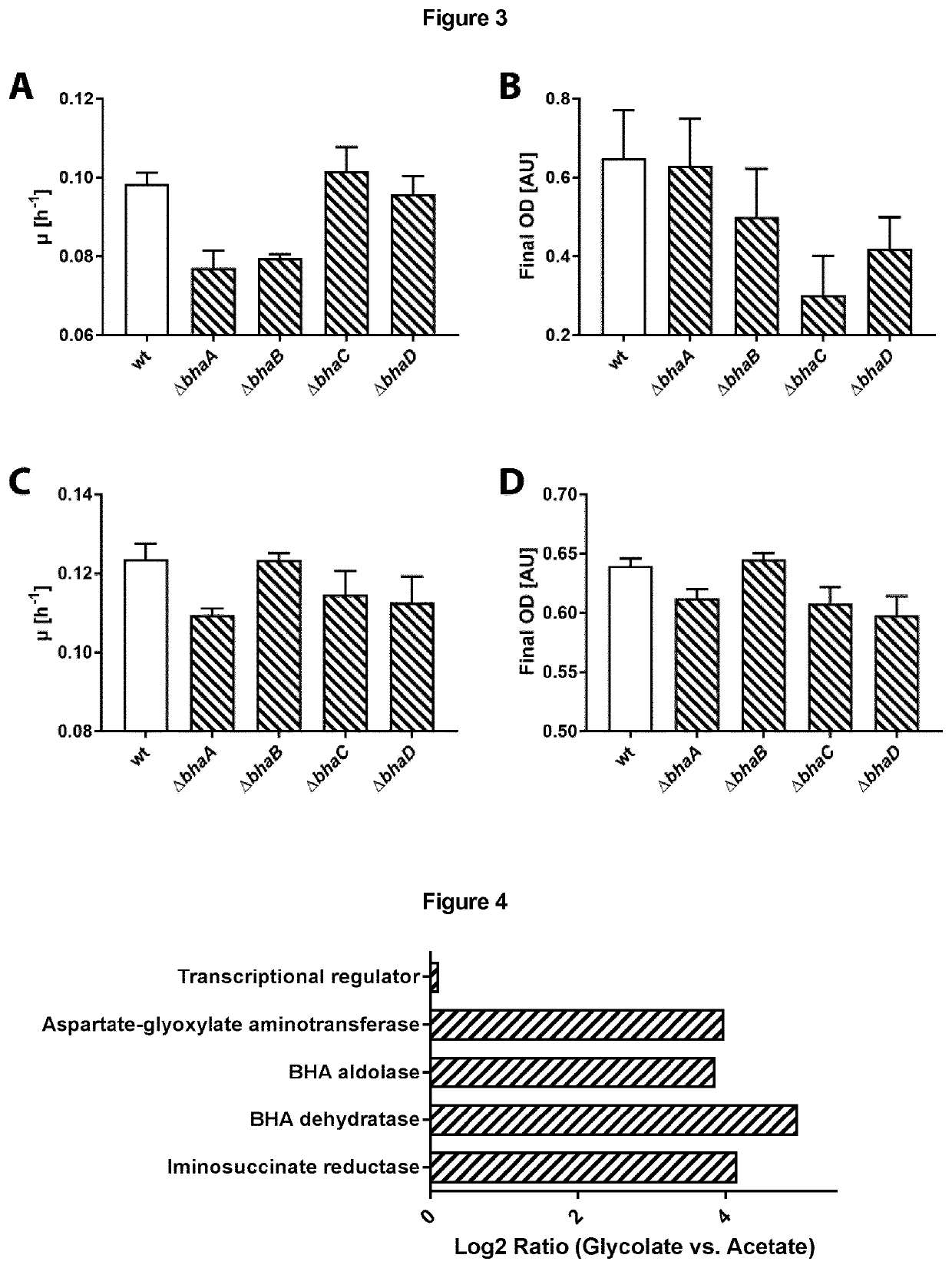Method of producing autotrophic organisms with altered photorespiration and improved co2 fixation
a technology of photorespiration and autotrophic organisms, which is applied in the direction of carbon-nitrogen lyases, lyases, transferases, etc., can solve the problems of limited sustainable autotrophic production of chemicals and fuels, inefficient production, and inability to achieve stable photorespiration and co2 fixation
- Summary
- Abstract
- Description
- Claims
- Application Information
AI Technical Summary
Benefits of technology
Problems solved by technology
Method used
Image
Examples
example 1
haracterization of the Enzymes of the β-Hydroxyaspartate Pathway (BHAP) and Reconstruction of the BHAP In Vitro
[0460]The genes encoding for the four enzymes of the BHAP in the genome of Paracoccus denitrificans DSM 413 were identified and these four proteins were heterologously expressed in E. coli. The four enzymes were purified and subjected to kinetic characterization by conducting suitable enzyme assays. Kinetic parameters of the enzymes are summarized in Table 1. The complete reaction sequence of the BHAP, catalyzed by these four enzymes, is shown in FIG. 1.
[0461]To assess the efficiency of the BHAP in converting its input molecule (glyoxylate) into its output molecule (oxaloacetate), a combined assay of all four enzymes was conducted. Additionally, the enzymes malate dehydrogenase (MDH) and formate dehydrogenase (FDH) were added. MDH converts oxaloacetate into malate, which can be analyzed well via LC-MS, while FDH as cofactor regeneration system is required for the regenerati...
example 3
tion of the Inducibility of BHAP Expression in the Presence of the Effector Glyoxylate
[0465]A whole-cell shotgun proteomics experiment was performed to investigate the expression levels of enzymes of the BHAP in cultures of P. denitrificans grown with different carbon substrates. As shown in FIG. 4, glycolate-grown cells show a strongly increased expression of all four enzymes of the BHAP compared to acetate-grown cells, while the expression level of the adjacent transcriptional regulator (BHAR) remains essentially unchanged. This suggests that either glycolate or a downstream reaction product thereof specifically induces expression of the enzymes of the BHAP.
[0466]Therefore, the DNA-binding properties of BHAR were determined by incubating the purified BHAR protein together with a DNA fragment of the operon's promoter region. As shown in FIG. 5, the protein bound to the promoter region (compare lane 1 and 2). This binding was decreased when adding increasing concentrations of glyoxy...
example 4
ing the BHAP as a Heterologous Photorespiration Bypass Pathway to Increase the Autotrophic Efficiency of Microorganisms
[0467]The experiments described above provide several lines of evidence supporting the notion that the BHAP can be applied as an inducible, heterologous photorespiration pathway in photosynthetic microorganisms. This means that with the addition of the two enzymes phosphoglycolate phosphatase and glyoxylate reductase (Hardy et al. Planta 1986, 168, 245; and Clark et al. Biochem J. cg 2009, 423, 15), the BHAP should be able to convert 2-phosphoglycolate, the toxic side product of photosynthesis, into a key metabolite in central carbon metabolism (see Table 2 and FIG. 6), notably without the release of CO2 and with low energy requirements, compared to other natural photorespiration pathways (see Table 3).
TABLE 2Required enzymes to convert 2-phosphoglycolate into oxaloacetate in the projected photorespiratory bypass. Substratesand products of all enzymes are given, wit...
PUM
| Property | Measurement | Unit |
|---|---|---|
| Fraction | aaaaa | aaaaa |
| Temperature | aaaaa | aaaaa |
| Temperature | aaaaa | aaaaa |
Abstract
Description
Claims
Application Information
 Login to View More
Login to View More - R&D
- Intellectual Property
- Life Sciences
- Materials
- Tech Scout
- Unparalleled Data Quality
- Higher Quality Content
- 60% Fewer Hallucinations
Browse by: Latest US Patents, China's latest patents, Technical Efficacy Thesaurus, Application Domain, Technology Topic, Popular Technical Reports.
© 2025 PatSnap. All rights reserved.Legal|Privacy policy|Modern Slavery Act Transparency Statement|Sitemap|About US| Contact US: help@patsnap.com



